Fire Danger Descriptions
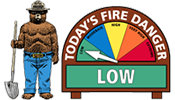 LOW Fires are not easily started. Fuels do not ignite readily from small firebrands, although, a more intense ignition source, such as lightning, may start many fires in duff or punky wood. Fires in open cured grassland may burn freely a few hours after rain, bur fires burning in forested areas spread slowly by creeping or smoldering and burn in irregular fingers. There is also a danger of spotting.
LOW Fires are not easily started. Fuels do not ignite readily from small firebrands, although, a more intense ignition source, such as lightning, may start many fires in duff or punky wood. Fires in open cured grassland may burn freely a few hours after rain, bur fires burning in forested areas spread slowly by creeping or smoldering and burn in irregular fingers. There is also a danger of spotting.
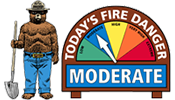 MODERATE Fires start easily and spread at a moderate rate. Fires can start from most accidental causes, but with the exception of lightning fires is some areas, the number of start is generally low. Fires in open-cured grassland will burn briskly and spread rapidly on windy days. Woods fires spread slowly to moderately fast. The average fire is of moderate intensity, although heavy concentrations of fuel may burn hot. Short-distance spotting may occur, but is not persistent. Fires are not likely to become serious, and control is relatively easy.
MODERATE Fires start easily and spread at a moderate rate. Fires can start from most accidental causes, but with the exception of lightning fires is some areas, the number of start is generally low. Fires in open-cured grassland will burn briskly and spread rapidly on windy days. Woods fires spread slowly to moderately fast. The average fire is of moderate intensity, although heavy concentrations of fuel may burn hot. Short-distance spotting may occur, but is not persistent. Fires are not likely to become serious, and control is relatively easy.
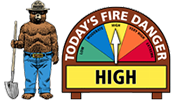 HIGH Fires start easily and spread at a fast rate. All fine dead fuels ignite readily and fires start easily from most causes. Unattended campfires are likely to escape. Fires spread rapidly and short-distance spotting is common. High-intensity burning may develop on slopes, or in concentrations of fine fuel. Fire may become serious and difficult to control unless they are hit hard and fast while small.
HIGH Fires start easily and spread at a fast rate. All fine dead fuels ignite readily and fires start easily from most causes. Unattended campfires are likely to escape. Fires spread rapidly and short-distance spotting is common. High-intensity burning may develop on slopes, or in concentrations of fine fuel. Fire may become serious and difficult to control unless they are hit hard and fast while small.
 VERY HIGH Fires start very easily and spread at a very fast rate. Fires start easily from all causes, spread rapidly and intensify quickly. Spot fires are a constant danger. Fires burning in heavy fuels may quickly develop high-intensity characteristics, such as long-distance spotting and fire whirlwinds. Direct attack at the head of such fires is rarely possible after they have been burning more than a few minutes.
VERY HIGH Fires start very easily and spread at a very fast rate. Fires start easily from all causes, spread rapidly and intensify quickly. Spot fires are a constant danger. Fires burning in heavy fuels may quickly develop high-intensity characteristics, such as long-distance spotting and fire whirlwinds. Direct attack at the head of such fires is rarely possible after they have been burning more than a few minutes.
 EXTREME The fire situation is explosive and can result in extensive property damage. Fires under extreme conditions start quickly, spread quickly, and burn intensely. All fires are a threat and potentially serious. Development in high-intensity burning will usually be faster and occur from small fires than in the "very high" danger class. Direct attack is rarely possible, and may be dangerous, except immediately after ignition. Fires burning in heavy slash or in conifer stands may be unmanageable while the extreme burning condition lasts. Under these conditions, the only effective and safe control action is on the flanks until the weather changes or until there is a decrease in the fuel supply.
EXTREME The fire situation is explosive and can result in extensive property damage. Fires under extreme conditions start quickly, spread quickly, and burn intensely. All fires are a threat and potentially serious. Development in high-intensity burning will usually be faster and occur from small fires than in the "very high" danger class. Direct attack is rarely possible, and may be dangerous, except immediately after ignition. Fires burning in heavy slash or in conifer stands may be unmanageable while the extreme burning condition lasts. Under these conditions, the only effective and safe control action is on the flanks until the weather changes or until there is a decrease in the fuel supply.

 Work Station: Grand Teton National Park Headquarters - Moose, Wyoming
Work Station: Grand Teton National Park Headquarters - Moose, Wyoming  creating world-renowned scenery that attracts visitors from all over the world. Park headquarters is located in Moose, Wyoming which is approximately 12 miles north of Jackson. Jackson is a small, outdoor recreation focused, thriving community of 8,000 year round residents. The town caters to four million tourists every summer, has an excellent hospital, a well respected public school system, private schools, multiple grocery stores, excellent restaurants, and seasonal music and art festivals. Outdoor activities are available year round and include easy access to three ski resorts (Snow King Resort, Jackson Hole Mountain Resort, and Grand Targhee), back-country and Nordic skiing, snowmobiling, hiking, camping, backpacking, horseback riding, boating, rafting, kayaking, hunting, cycling, mountain biking, and world class fly fishing, climbing, and mountaineering. The climate can be as extreme as the activities that are available. Winter temperatures range between lows of -20 to highs in the 30’s. Summer temperatures are comfortable, with highs between 65 - 80 degrees.
creating world-renowned scenery that attracts visitors from all over the world. Park headquarters is located in Moose, Wyoming which is approximately 12 miles north of Jackson. Jackson is a small, outdoor recreation focused, thriving community of 8,000 year round residents. The town caters to four million tourists every summer, has an excellent hospital, a well respected public school system, private schools, multiple grocery stores, excellent restaurants, and seasonal music and art festivals. Outdoor activities are available year round and include easy access to three ski resorts (Snow King Resort, Jackson Hole Mountain Resort, and Grand Targhee), back-country and Nordic skiing, snowmobiling, hiking, camping, backpacking, horseback riding, boating, rafting, kayaking, hunting, cycling, mountain biking, and world class fly fishing, climbing, and mountaineering. The climate can be as extreme as the activities that are available. Winter temperatures range between lows of -20 to highs in the 30’s. Summer temperatures are comfortable, with highs between 65 - 80 degrees. 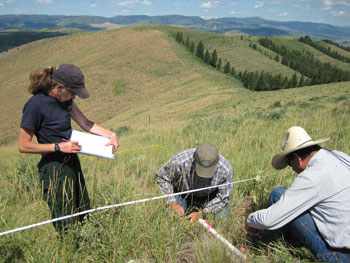 Grand Teton National Park and the Bridger-Teton National Forest. The primary responsibilities of the fire effects crewmember positions are to serve as biological science technicians for wildland and prescribed fire projects as well as mechanical fuel treatments. The crew establishes and monitors fuels and vegetation plots before and after fire and fuels treatments in a range of ecosystems, including high elevation mixed conifer forests, aspen stands, sagebrush steppe, and riparian areas. Crewmembers assist in the identification of grasses, herbs, shrubs, and trees. Crewmembers are also responsible for managing the data collected, including data input and storage and updating and analyzing fire effects data. The crew also participates in an extremely diverse fire management program.
Grand Teton National Park and the Bridger-Teton National Forest. The primary responsibilities of the fire effects crewmember positions are to serve as biological science technicians for wildland and prescribed fire projects as well as mechanical fuel treatments. The crew establishes and monitors fuels and vegetation plots before and after fire and fuels treatments in a range of ecosystems, including high elevation mixed conifer forests, aspen stands, sagebrush steppe, and riparian areas. Crewmembers assist in the identification of grasses, herbs, shrubs, and trees. Crewmembers are also responsible for managing the data collected, including data input and storage and updating and analyzing fire effects data. The crew also participates in an extremely diverse fire management program. 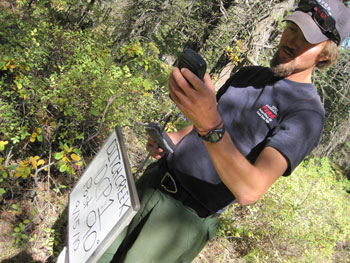 Crewmembers often serve as prescribed fire monitors, collecting and evaluating weather, fuels, topography, smoke, and fire behavior data for prescribed and wildland fires. Teton Interagency Fire includes a helitack crew, fuels crew, type 2IA hand crew, and several engine crews, and fire effects crewmembers have the potential to detail to any of these during a given season. Responsibilities are commensurate with qualifications, but could include all aspects of wildland and prescribed fire operations such as preparation, ignition, suppression, monitoring, holding, mop-up, and rehabilitation. Crewmembers collect fire weather data and fuel and soil moisture samples, map projects, and maintain appropriate records. Fire effects monitoring is an important step in evaluating the success of both planned and unplanned fire, and reporting results back to burn bosses and FMOs insures that prescriptions can be refined or adjusted. Crewmembers are expected to maintain a high level of physical fitness. The length of season is flexible, but crewmembers can expect to work from late May into October.
Crewmembers often serve as prescribed fire monitors, collecting and evaluating weather, fuels, topography, smoke, and fire behavior data for prescribed and wildland fires. Teton Interagency Fire includes a helitack crew, fuels crew, type 2IA hand crew, and several engine crews, and fire effects crewmembers have the potential to detail to any of these during a given season. Responsibilities are commensurate with qualifications, but could include all aspects of wildland and prescribed fire operations such as preparation, ignition, suppression, monitoring, holding, mop-up, and rehabilitation. Crewmembers collect fire weather data and fuel and soil moisture samples, map projects, and maintain appropriate records. Fire effects monitoring is an important step in evaluating the success of both planned and unplanned fire, and reporting results back to burn bosses and FMOs insures that prescriptions can be refined or adjusted. Crewmembers are expected to maintain a high level of physical fitness. The length of season is flexible, but crewmembers can expect to work from late May into October.  Specialized Experience: Must have one year of specialized experience equivalent to at least the GS-4 level which is in or related to the line of work of the position andwhich provided the knowledge, skills, and abilities necessary to successfully perform the duties of a fire effects monitor. This experience includes, but is not limited to: biological science technician or forestry technician work, or work related to firefighting, botany, plant identification, forest inventory, silviculture, or data management. OR Education: Must have successfully completed four years of education above the high school level from an accredited college or university. One year is generally defined as 30 semester hours or 45-quarter hours. (Transcripts must be submitted). OR Combinationof Experience and Education: Equivalent combinations of successfully completed undergraduate educationandexperience (as described above) may be used to meet total qualification requirements. (Transcripts must be submitted). *Note: Prior experience as a wildland firefighter, while highly desirable, is not a prerequisite of employment. Basic firefighter training will beprovided if necessary. Actual duties will be commensurate with experience level and qualifications.
Specialized Experience: Must have one year of specialized experience equivalent to at least the GS-4 level which is in or related to the line of work of the position andwhich provided the knowledge, skills, and abilities necessary to successfully perform the duties of a fire effects monitor. This experience includes, but is not limited to: biological science technician or forestry technician work, or work related to firefighting, botany, plant identification, forest inventory, silviculture, or data management. OR Education: Must have successfully completed four years of education above the high school level from an accredited college or university. One year is generally defined as 30 semester hours or 45-quarter hours. (Transcripts must be submitted). OR Combinationof Experience and Education: Equivalent combinations of successfully completed undergraduate educationandexperience (as described above) may be used to meet total qualification requirements. (Transcripts must be submitted). *Note: Prior experience as a wildland firefighter, while highly desirable, is not a prerequisite of employment. Basic firefighter training will beprovided if necessary. Actual duties will be commensurate with experience level and qualifications.